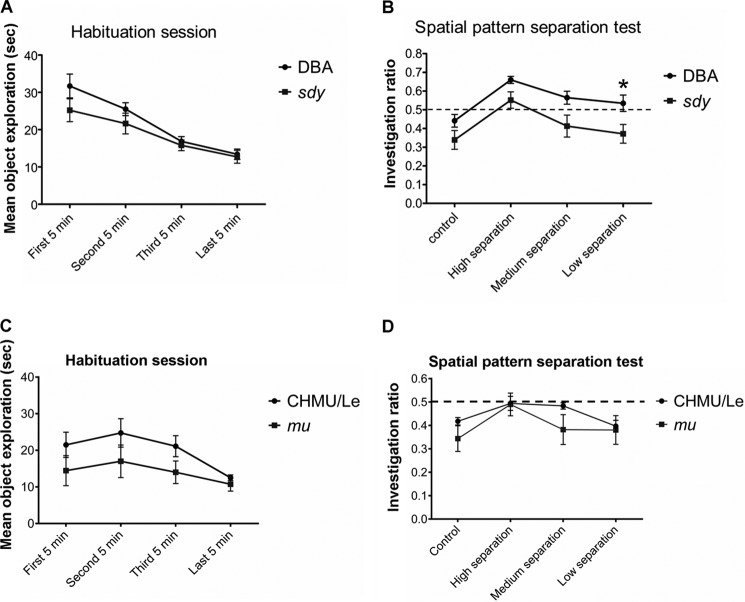FIGURE 6.
sdy mice displayed impaired spatial pattern separation capacity. A, for the habituation period, both wild-type (WT, DBA/2J) and sdy mice display adaptability to the stimulus objects as demonstrated by a decrease in the time spent exploring the objects during the 20-min interval. The interaction between the genotype and exploration time is not statistically significant (F1, 54 = 3.20, p = 0.09, n = 12). B, under higher difficulty discrimination conditions, the sdy mice showed impaired spatial pattern separation capacity. An exploration ratio of >0.5 indicates the ability of a mouse to discriminate a change in spatial orientation. As a control, when there was no change in the object location between habituation and test sessions (20 cm apart), all of the mice showed shorter investigation durations. During the test session, the genotypes (WT and sdy) affects pattern separation performance significantly during various separation conditions (F1, 22 = 7.58, p = 0.01, n = 12). Both sdy and control mice discriminate a high spatial separation (55 cm apart) between the stimulus objects (WT, 0.66 ± 0.02 versus sdy, 0.55 ± 0.04, post hoc t = 1.76, p = 0.33, n = 12). At the medium (45 cm apart) and the low (35 cm apart) spatial separation, only the wild-type mice are able to discriminate the difference in spatial orientation of the objects, but sdy mice show a lack of spatial pattern separation ability. Notably, the performance of sdy at low separation is significantly impaired compared with the wild-type mice (medium, WT 0.56 ± 0.03 versus sdy 0.41 ± 0.06; post hoc t = 2.48, p = 0.06, n = 12; low, WT 0.53 ± 0.04 versus sdy 0.37 ± 0.05, post hoc t = 2.66, *, p = 0.037, n = 12). Data are expressed as mean ± S.E. C, using the same method described in A, during the habituation period both wild-type (WT, CHMU/Le) and mu mice display adaptability to the stimulus objects as demonstrated by a decrease in time spent exploring the objects during the 20-min interval. The interaction between the genotypes and exploration time is not statistically significant (F3, 42 = 0.60, p = 0.62, n = 12). D, using the same method described in B, when there was no change in the object location between habituation and test sessions (20 cm apart), all of the mice showed shorter investigation durations. During the test session, both WT and mu mice show similar pattern separation capacity during various separation conditions (F1, 14 = 1.72, p = 0.21, n = 12).

